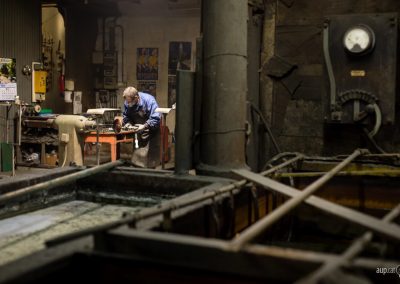P1: Torre dels Predicadors (Tower of the Preachers)
First stop
Torre dels Predicadors (Tower of the Preachers)
In addition to the factories that have been demolished, from here you can see two more factories that are still in operation: the Nestlé factory in Sant Gregori and the Torraspapel factory in Sarrià de Ter.
The most accepted theory at the moment is that of Schrödinger, which states that the electron, rather than a planet in a solar system, as suggested by Bohr, looks like a wave.
This is a good spot to get an idea of how big an atom is and the relative sizes of its components. If we compare the hydrogen atom, which is the simplest (since it only has one proton in the nucleus and one electron), with where we are, and if the nucleus were a sphere the diameter of the tower, the electron would be the size of a lentil, and would be spinning around at an approximate distance of 500 km.

Did you know?
Many artists have followed scientific discoveries with great interest and included them in their work. For example, Salvador Dalí was interested in a variety of topics; one of them was science. Throughout his life, certain scientific subjects left quite an impression on him, and some of his paintings show this. For example, during the 1930s he was interested in optical illusions and painted double images, which were repeated often in his work.
In the 1940s, he was interested in Planck’s quantum theory. In the 1950s, he began his corpuscular paintings, which were influenced by atomic theories. Between the 60s and 70s, he was interested in genetics, specifically in the structure of DNA, and also in lasers, which led him to create his first exhibition of holograms and stereo paintings. Finally, in the the 80s, he focused on mathematician René Thom’s catastrophe theory.
Àtoms
El concepte d’àtom existeix des de l’Antiga Grècia proposat pels filòsofs grecs Demòcrit, Leucip i Epicur. No obstant això, el concepte no es va generar per mitjà de l’experimentació, sinó com una necessitat filosòfica que expliqués la realitat, ja que, com proposaven aquests pensadors, la matèria no podia dividir-se indefinidament, pel que havia d’existir una unitat o bloc indivisible i indestructible que al combinar-se de diferents formes creés tots els cossos macroscòpics que ens envolten. Segons els alquimistes, la matèria estava formada per quatre elements: aire, aigua, terra i foc, al que se li afegí un cinquè element: l’èter. La concepció de l’àtom que s’ha tingut al llarg de la història, ha variat d’acord als descobriments realitzats en el camp de la física i la química.
La visió moderna de l’estructura interna de la matèria va haver d’esperar fins a l’experiment de Rutherford al 1911 i al model atòmic de Bohr. Posteriors descobriments científics, com la teoria quàntica, i avanços tecnològics, com e microscopi electrònic, han permès conèixer amb major detall les propietats físiques i químiques dels àtoms.
La teoria acceptada actualment é que l’àtom es compon d’un nucli de càrrega positiva, format per protons i neutrons, en conjunt coneguts com nucleó, al volant del qual es troba un núvol d’electrons de càrrega negativa. La major part d ela massa d’un àtom es concentra en el nucli (format per protons i neutrons, els quals són 1836 i 1838 vegades més pesants que l’electró, respectivament). El volum exacte d’un àtom és difícil de calcular, ja que els núvols d’electrons no conten amb vores definides, però pot estimar-se raonadament en 1,0586 x 10-15m es veu que el nucli d’un àtom és prop de 100.000 vegades menor que l’àtom mateix, i no obstant això, concentra pràcticament el 100% de la seva massa.



















